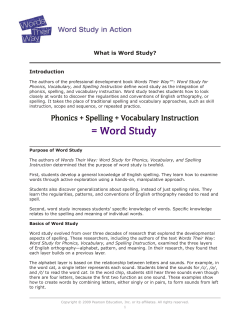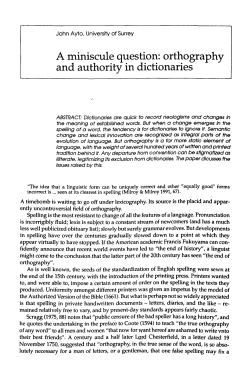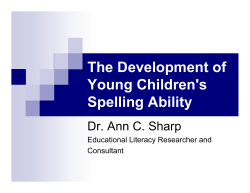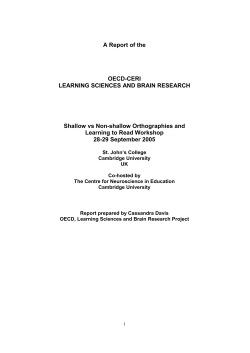
What Do Spelling Errors Tell Us about Language Knowledge?
What Do Spelling Errors Tell Us about Language Knowledge? Jan Wasowicz, Ph.D. Evanston, IL Like reading, spelling is a written language skill that draws upon an individual’s repertoire of linguistic knowledge, including phonological awareness, and kno wledge of orthography, vocabulary, morphological and semantic relationships; and mental orthographic images (Apel & Masterson, 2001; Apel, Masterson, & Niessen, 2004). Each of these areas of linguistic or “word study” knowledge contributes to spelling success (Treiman & Bourassa, 2000) and a deficit in any one of these areas of word study knowledge will manifest as a specific pattern of misspelling. Accordingly, the analysis of an individual’s spelling errors can be used to identify underlying linguistic deficits. The Language of Spelling Phonological Awareness Individuals rely upon the phonological awareness skills of phoneme segmentation, sequencing, discrimination, and identification during the spelling or “encoding” process. They use phonological segmentation skills when spelling by breaking down words into smaller units-such as syllables and phonemes-then linking these smaller units to their written forms. They use sound sequencing skills to map the letters to sounds in the correct order. They use phoneme discrimination and identification skills to perceive differences between speech sounds (e.g., between the short vowel e and short vowel i sounds) and to recognize that a difference in sound signals a difference in meaning. Orthographic Knowledge Individuals also draw upon the ir orthographic knowledge during the encoding process. Specifically, individuals draw upon their knowledge of sound- letter relationships and knowledge of letter patterns and conventional spelling rules to convert spoken language to written form (Ehri, 2000; Treiman & Bourassa, 2000). Orthographic knowledge includes knowledge of specific letter-sound relationships (e.g., the / k /sound can be represented by the letters c, k, ck, cc, lk, ch, que); knowing which letter patterns are acceptable (e.g., the / k /sound is almost always spelled with the letter k at the end of a word after a long vowel sound); and understanding sound, syllable, and word position constraints on spelling patterns (e.g., the / k /sound at the beginning of a word is never spelled with the letters ck, cc, lk). Copyright © 2007 Learning By Design, Inc. All rights reserved. www.learningbydesign.com Vocabulary Individuals use vocabulary knowledge to accurately store and retrieve the correct spelling of words. The knowledge of word meaning is particularly important for the correct spelling of homophone words (e.g., bare and bear). Vocabulary knowledge is also helpful to correctly spell the wh consonant digraph because the / w / sound at the beginning of question words (what, where, when, why, which) is always spelled with the letters wh. Morphological Knowledge & Semantic Relationships Individuals also rely upon their morphological knowledge and knowledge of semantic relationships when spelling inflected or derived forms of words (Carlisle, 1995). Specifically, individuals rely upon their knowledge of letter- meaning relationships of individual morphemes (i.e., suffixes, prefixes, base words, and word roots), their understanding of semantic relationships between a base word and related words, and their knowledge of modification rules when adding prefixes and suffixes. Inflected words contain suffixes that provide information about time or quantity without changing the meaning or class of the words (e.g., walk-walked; cat-cats).Derived words contain affixes (prefixes or suffixes) that change the meaning and sometimes the class of words (e.g., cycle–recycle; friend–friendly).When an individual is required to spell an unfamiliar word (e.g., exception), knowledge of the base word (i.e., except) and certain word endings (e.g.,-ion) can help the student spell the unfamiliar word correctly. An individual draws upon knowledge of rules for modifying base words to correctly spell inflected and derived forms of words. Individuals also draw upon knowledge of semantic relationships and rules for modifying words to spell irregular plural nouns, irregular pasttense verbs, contractions, and possessive nouns. The use of knowledge of word parts and related words to spell words becomes increasingly important as individuals begin to spell words of greater length and complexity. Mental Orthographic Images Individuals need to develop clear and complete mental representations of previously read words. These mental images of words, also known as mental ortho graphic images (MOIs), are stored in an individual’s long-term memory after repeated exposure to them in print (Ehri & Wilce, 1982; Glenn & Hurley, 1993). Inadequate MOIs are often formed when individuals use inappropriate reading strategies such as partial cue analysis, a process whereby the student guesses the identity of a word after decoding only the first letter(s) of the word. Clearly and completely developed MOIs allow individuals to quickly recall and correctly spell words and word parts. Individuals must rely upon the mental image of a word when phonological awareness and knowledge of orthography, vocabulary, word parts, and related words are not sufficient to correctly spell a spelling pattern within a word (e.g., rope not roap, bucket not buckit, actor not acter). Copyright © 2007 Learning By Design, Inc. All rights reserved. www.learningbydesign.com Both children and adults use these different types of language knowledge throughout spelling development (Treiman & Bourassa, 2000). The amount that each area contributes to spelling development differs depending on an individual’s literacy experiences and the complexity of the words needing to be spelled. Initially, phonological awareness skills play a large role in early spelling development, yet other linguistic knowledge, such as orthographic knowledge and rudimentary morphological knowledge, may also be contributing factors (Treiman & Bourassa, 2000). With additional experiences and learning, spelling development may be positively affected through a deeper understanding and increased use of orthographic, morphological, and semantic knowledge and a larger number of clear mental orthographic images. At any point in spelling development, an individual’s spelling reflects his or her linguistic knowledge and literary capabilities at that moment in time. Accordingly, an individual’s misspellings are the “window” to underlying linguistic deficits. Spelling Errors Reveal Linguistic Deficits It is possible to identify an individual’s linguistic deficits through spelling error analysis because a specific pattern of misspelling is associated with each specific type of linguistic deficit. Analysis of an individual’s spelling errors reveals underlying deficits in phonological awareness, and in knowledge of orthography, vocabulary, morphological and semantic relationships, and mental orthographic images. Phonological Awareness When phonological awareness skills are weak or underdeveloped, spelling is negatively affected in very predictable ways. Typically, individuals with poor phonological segmentation skills will delete letters and syllables, usually omitting letters for less salient phonemes, especially those that occur in internal locations and in unstressed syllables, (e.g., pat for past, relize for realize). Individuals with poor sound sequencing skills commonly reverse the sequence of letters when spelling. Letters reversals most commonly occur for liquids and nasals in a word or syllable sequence (e.g., flod for fold, bets for best). Individuals with poor phoneme discrimination and identification skills are likely to spell distinct vowel sounds with the same letter (e.g., bet and bit both spelled bet), and add letters for phonemes that do not occur in a word (e.g., ment for met). Orthographic Knowledge Individuals whose orthographic knowledge is deficient often spell words incorrectly because they fail to recognize accepted spelling conventions. As such, the misspellings of individuals with orthographic knowledge deficits are predictably characterized by “illegal” substitutions (e.g., cas for catch), non-allowable letter sequences (e.g., jrum for drum; kween for queen), phonetically possible spellings that violate “rules” (e.g., ran for rain; coatch for coach), and violation of word position constraints (e.g., fuj for fudge). Copyright © 2007 Learning By Design, Inc. All rights reserved. www.learningbydesign.com Vocabulary Individuals who have trouble applying vocabulary knowledge will confuse the spelling of homophone words (e.g., bear for bare) and parts of other words in which the correct spelling is determined by word meaning (e.g., the / w / sound at the beginning of question words what, where, when, why, which is misspelled as w). Morphological Knowledge & Semantic Relationships Deficits in morphological knowledge and knowledge of semantic relationships present their own predictable patterns of misspellings. The misspellings of individuals with these types of deficits are characterized by omission of morphemes (e.g., walk for walked), phonetic spelling of morphemes (e.g., walkt for walked, musishun for musician), failure to use spelling of the semantically related base word to correctly spell the inflected or derived form (e.g., ascend but assension for ascension), and misspelling of modifications when spelling inflected and derived forms of words (e.g., calfes for calves, crazyness for craziness). Mental Orthographic Images When mental orthographic images are weak or not fully developed, spelling is negatively affected in very predictable ways. The misspellings of individuals with weak or “fuzzy” mental images of words are characterized by “legal” substitutions (e.g., hed for head, roap for rope, lagh for laugh), misspelling of unstressed vowel sounds (e.g., buckit for bucket, acter for actor, bottle for bottle), and homophone confusions (e.g., bear vs. bare, won vs. one, which vs. witch). Figure 1 The writing sample in Figure 1 was collected from Marissa, a seventh- grade student. It reveals a variety of linguistic deficits, including deficits in phonological awareness (e.g., repluic for republic, indivial for individual, Amarican for America), vocabulary Copyright © 2007 Learning By Design, Inc. All rights reserved. www.learningbydesign.com knowledge (e.g., two for to and wich for which), morphological knowledge (e.g., justos for justice), and mental orthographic images (e.g., pleage for pledge). Conducting an Error Analysis of Misspelled Words Using carefully constructed word lists that represent specific types of spelling knowledge used throughout the spelling-acquisition process and a theoretically grounded error analysis methodology, it is possible to collect and analyze an individual’s spelling for patterns of errors and to determine the linguistic deficits that are interfering with that individual’s spelling and reading. Once the linguistic deficits are identified, the professional has a clear roadmap for systematic instruction or remediation of spelling and related linguistic skills. This prescriptive method of assessment--also called a “multiple linguistic repertoire analysis--is very different from standardized spelling tests such as The Test of Written Spelling-4 (TWS-4; Larsen, Hammill, & Moats, 1999) or the Wide Range Achievement Test-4 (WRAT-4; Glutting & Wilkinson, 2005), which quantify spelling performance relative to peers. It is also very different from Stage Theory and spelling inventories (e.g., Bear, Invernizzi, Templeton, & Johnston, 2000) that describe what letter patterns a student can and cannot spell. A prescriptive assessment goes beyond these other measures by using error analysis to determine why a student misspells words (i.e., what are the underlying linguistic deficits) and precisely what type of word study instruction is needed. The multiple linguistic repertoire analysis method described here was first published by Masterson and Apel (2000). The method was further developed and subsequently republished by Apel, Masterson, and Niessen (2004). This method of assessment is implemented in the SPELL and SPELL-2 software assessment programs (Masterson, Apel, & Wasowicz, 2002; Masterson, Apel, & Wasowicz, 2006). Software programs save valuable time and enormously simplify the tedious task of conducting a prescriptive assessment. A criterion validity study (Masterson & Mooney, 2006) conducted with 135 students in grades 1-6 compared participants’ performance on SPELL to their performance on two subtests of the Woodcock Diagnostic Reading Battery (Woodcock, 1997) and the Test of Written Spelling-4 (TWS-4; Larsen, Hammill, & Moats, 1999). Pearson-r correlations and multiple regression analysis indicate SPELL validly measures students’ spelling abilities, decoding skills, and identification of sight words and that SPELL can be used to identify word study goals in a variety of grades and settings. However, a software program is not required to conduct a prescriptive spelling assessment. The principles and methods of the prescriptive assessment described in Steps 1-4 below can be applied by hand to identify an individual’s specific language deficits and to create an individualized intervention plan. There are four basic procedural steps for completing the prescriptive assessment. Step 1: As with any other measure of assessment, it is imperative that you begin with an adequate sample of the individual’s spelling errors so that the error analysis yields valid results. To do so, you must collect an adequate sample of Copyright © 2007 Learning By Design, Inc. All rights reserved. www.learningbydesign.com spelling for each spelling pattern (e.g., short vowel a, s-clusters, silent consonants, unstressed vowels, inflected words) within the individual student’s developmental spelling level. The domain of spelling patterns in the English language is quite large and several exemplars of each pattern must be collected to obtain a representative sample of the student’s spelling ability. A minimum of three exemplars for each spelling pattern is recommended. Depending on the developmental spelling level of the student, this may require a spelling sample of 80-185 words. Step 2: Examine the student’s spelling of each spelling pattern to identify which spelling patterns are most frequently misspelled. These are the spelling patterns that will be targeted with explicit word- level instruction to remediate specific language deficits. Spelling patterns that are infrequently misspelled (greater than 60% accuracy) are more appropriately addressed by facilitating and reinforcing the student’s consistent application of language knowledge when writing, and by developing the student’s self- monitoring and proofing of his or her own written work in authentic writing tasks. Step 3: For each spelling pattern identified and selected in Step 2, carefully analyze the nature of the individual student’s spelling errors. This detailed error analysis determines if the misspelling of a particular spelling pattern is caused by a deficit in phonological awareness, and/or in knowledge of orthography, vocabulary, morphological and semantic relationships, or mental images of words. A step-by-step flowchart is publicly available on the internet (www.learmingbydesign.com) to assist the clinician in cond ucting this detailed error analysis by hand and a detailed, case-study example of how to complete the SPELL prescriptive assessment is presented in Wasowicz, Apel, and Masterson (2003). Step 4: Write an instructional goal for each selected spelling pattern, indicating the most appropriate instructional method for the individual student for each spelling pattern. For example, “Student will improve spelling of the short vowel a sound by developing the skills to discriminate among vowel sounds and to map letters to sounds in words containing this spelling pattern. Student will improve spelling of derived words by developing knowledge of letter- meaning relationships for derivational suffixes and rules for modifying words when adding suffixes.” This method of assessment has been successfully performed using the SPELL software with individuals as young as seven years of age, and with a variety of clinical populations including individuals with language impairments, severe speech and physical impairments, and hearing impairments; as well as with students who are in general education (Apel, Masterson, & Hart, 2004; Hart, Scherz, Apel, & Hodson, 2006; Kelman & Apel, 2004; Yakey, Wilkerson, & Throneburg, 2006). When done properly, this type of analysis may even be mo re sensitive than standardized measures of linguistic competencies. In other words, a student may score within normal limits on the more Copyright © 2007 Learning By Design, Inc. All rights reserved. www.learningbydesign.com general measure associated with the standardized test, yet linguistic deficits can be uncovered through spelling error analysis. Once the linguistic deficits are identified, the clinician has a clear roadmap for systematic instruction or remediation of spelling and related linguistic skills. Research indicates that a multiple- linguistic approach to spelling instruction, as prescribed by SPELL and SPELL–2, leads to significant improvement in spelling performance and word- level reading ability (Kelman & Apel, 2004). When compared with traditional spelling instruction, the multiple- linguistic approach to spelling instruction, as prescribed by SPELL and SPELL–2, is significantly more effective (Apel, Masterson, & Hart, 2004). Figure 2 The writing sample in Figure 2 was collected from Marissa after one year of multiple- linguistic spelling instruction prescribed by the SPELL method of assessment. In comparison to her previous writing sample, a smaller number of spelling errors occurred and the misspellings are qualitatively different. This writing sample reflects Marissa’s phonological competenc y coupled with more robust mental orthographic images of words after receiving multiple- linguistic spelling instruction. Dr. Jan Wasowicz is president of Learning By Design Inc. and a private SLP practitioner in Evanston, IL. She is a coauthor of SPELL Spelling Performance Evaluation for Language & Literacy and SPELL-Links to Reading & Writing. Copyright © 2007 Learning By Design, Inc. All rights reserved. www.learningbydesign.com References Apel, K., & Masterson, J. J. (2001). Theory- guided spelling assessment and intervention. Language, Speech, and Hearing Services in the Schools, 32, 182-195. Apel, K., Masterson, J. J., & Niessen, N. L. (2004). Spelling assessment frameworks. In A. Stone, E. R. Silliman, B. Ehren, & K. Apel (Eds.), Handbook of Language and Literacy: Development and Disorder (pp. 644-660). New York: Guilford Press. Apel, K., Masterson, J. J., & Hart, P. (2004). Integration of language components in spelling: Instruction that maximizes students’ learning. In E. R. Silliman and L. C. Wilkinson (Eds.), Language and literacy learning in schools (pp. 292-315). New York: Guilford Press. Bear, D., Invernizzi, M., Templeton, S., & Johnston, F. (2000). Words their way: Word study for phonics, vocabulary, and spelling instruction (2nd ed.). Upper Saddle River, NJ: Prentice Hall. Carlisle, J. F. (1995). Morphological awareness and e arly reading achievement. In L. B. Feldman (Ed.), Morphological aspects of language processing (pp. 189-209). Hillsdale, NJ: Erlbaum. Ehri, L. C. (2000). Learning to read and learning to spell: Two sides of a coin. Topics in Language Disorders, 20(3), 19-36. Ehri, L. C., & Wilce, L. (1982). Recognition of spellings printed in lower and mixed case: Evidence for orthographic images. Journal of Reading Behavior, 14, 219-230. Glenn, P., & Hurley, S. (1993). Preventing spelling disabilities. Child Language Teaching and Therapy, 9, 1-12. Glutting, J., & Wilkinson, G. (2005). Wide Range Achievement Test (4th ed.;WRAT-4). Austin, TX: Pro-Ed. Hart, P., Scherz, J, Apel, K., & Hodson, B. (July 8, 2006). Analysis of spelling error patterns of individuals with complex communication needs and physical impairments. Augmentative and Alternative Communication, 1–14. Kelman, M., & Apel, K. (2004). The effects of a multiple linguistic, prescriptive approach to spelling instruction: A case study. Communication Disorders Quarterly, 25(2), 56-66. Larsen, S., Hammill, D., & Moats, L. (1999). Test of Written Spelling (4th ed.; TWS-4). Austin, TX: Pro-Ed. Masterson, J. J., & Apel, K., (2000). Spelling assessment: Charting a path to optimal intervention. Topics in Language Disorders, 20(3), 50-65. Masterson, J. J., & Mooney, R. (2006, February). Criterion validity of the spelling performance evaluation for language and literacy (SPELL). Poster presented at the Annual Pathways to Communication Conference, Missouri State University, Springfield, MO. Masterson, J. J., Apel, K., & Wasowicz, J. (2002). SPELL Spelling Performance Evaluation for Language and Literacy [Computer software]. Evanston, IL: Learning By Design. www.learningbydesign.com Copyright © 2007 Learning By Design, Inc. All rights reserved. www.learningbydesign.com Masterson, J. J., Apel, K., & Wasowicz, J. (2006). SPELL-2 Spelling Performance Evaluation for Language and Literacy (2nd ed.) [Computer software]. Evanston, IL: Learning By Design. www.learningbydesign Treiman, R., & Bourassa, D. C. (2000). The development of spelling skills. Topics in Language Disorders, 20(3), 1-18. Wasowicz, J., Apel, K., & Masterson, J. J. (2003). Spelling assessment: Applying research in school-based practice. Perspectives on School-Based Issues Newsletter, 4(1), 3-7. Woodcock, R. (1997). Woodcock Diagnostic Reading Battery. Itasca, IL: Riverside Publishing. Yakey, B., Wilkerson, L., & Throneburg, R. (2006, November). Language-based spelling instruction for children who are hard of hearing. Poster presented at the annual conference of the American Speech, Language, and Hearing Association, Miami, FL. Copyright © 2007 Learning By Design, Inc. All rights reserved. www.learningbydesign.com
© Copyright 2025





















